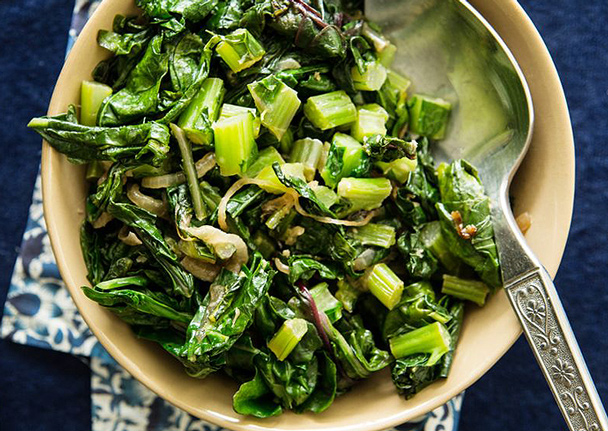
Swiss Chard with Horseradish
Makes 8 servings
- Active time: 30 min
Total time: 45 min

We prefer green Swiss chard in this recipe because it cooks up a brighter green than red or rainbow chard and the stems are more tender, but if you can't find the green, don't hesitate to use other chards.
This recipe is part of our Gourmet Modern Menu: A Hanukkah Feast. Click here to view the full menu.
Published in Gourmet Live
12.05.12
INGREDIENTS:
- 3 pounds green Swiss chard (2 to 3 bunches; see Cooks' Notes)
- 3 tablespoons olive oil
- 1 medium onion, halved lengthwise and thinly sliced
- 3 tablespoons water
- 1/2 teaspoon salt
- 1 1/2 tablespoons bottled white horseradish (not drained), or to taste
INSTRUCTIONS:
-
Cut out stems and center ribs from chard, discarding any tough parts (see Cooks' Notes), then chop. Wash leaves well, then cut in half crosswise (leave whole if on the smaller side).
-
Heat oil in a wide heavy pot (5- to 7-quart capacity) over medium heat until shimmering, then cook onion, stirring occasionally, until it begins to soften, about 5 minutes. Add chard stems and ribs, the water, and 1/2 teaspoon salt, and cook, covered, until just tender, 8 to 10 minutes.
-
Increase heat to medium-high. Add leaves in handfuls, turning with tongs and adding more as previous batches wilt, until all leaves have been added to pot. Cover with lid, then reduce heat to medium and cook, stirring once or twice, until just tender (do not overcook), 2 to 3 minutes. Remove from heat and stir in horseradish.
COOKS' NOTES:
-
Chard tends to be quite sandy, so you will likely need to wash it in several changes of cold water in a large, deep bowl or clean sink. If cooking right away, just drain it in a colander, but don't spin it dry.
-
Raw chard can be sliced and chopped 1 day ahead; keep leaves and ribs in separate resealable plastic bags. If it is still wet from washing, spin it dry and stick a paper towel in each bag (wet greens in plastic bags deteriorate quickly). When cooking, you'll likely need to add a little more water to make up for the water not still clinging to the leaves.
-
Green Swiss chard has wider stems than red or rainbow chard. Bunches vary in how much of the stem is attached, so the amount of pale stems and green leaves you end up with in 3 pounds will vary.
- Keywords
- Gourmet Live,
- Hanukkah


 Pinterest
Pinterest


